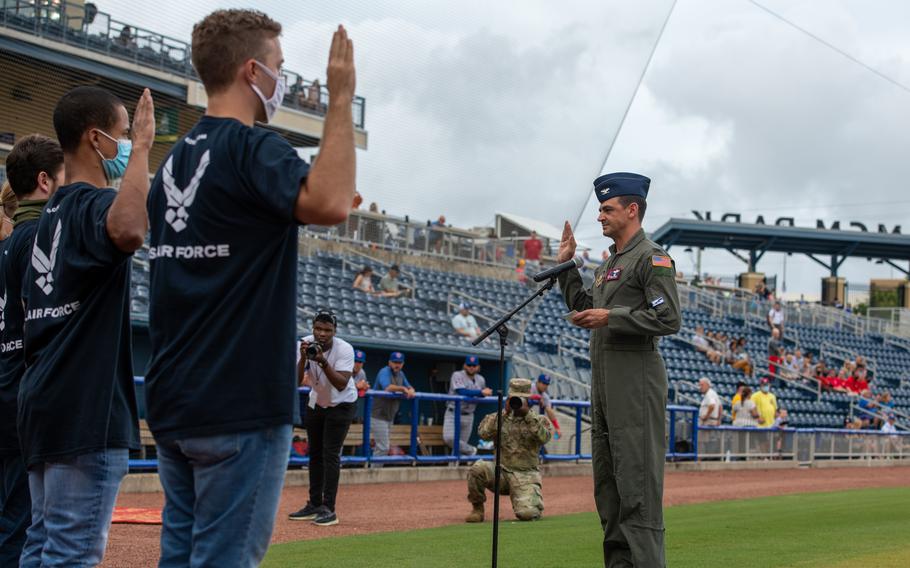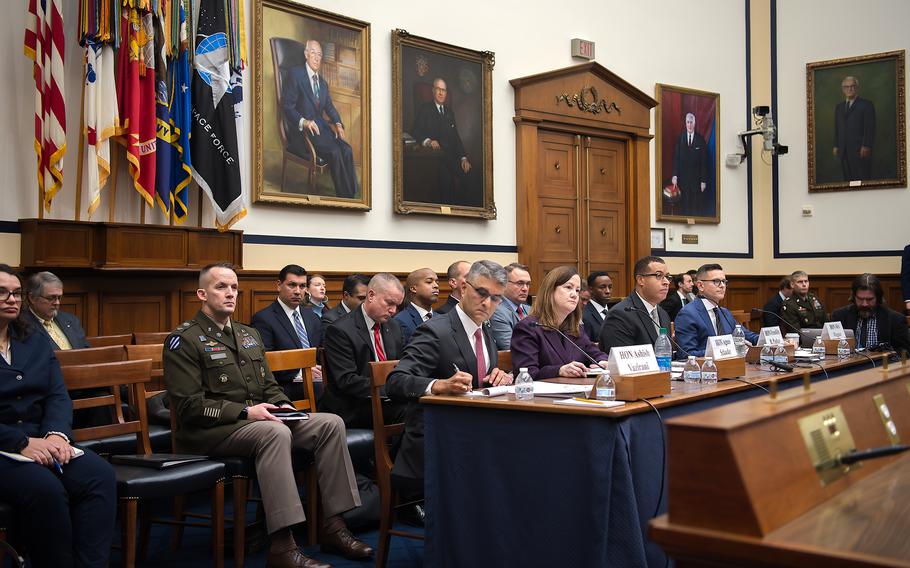
Air Force Col. Stuart M. Rubio, 403rd Wing commander, performs an oath of enlistment ceremony for new trainees during the Biloxi Shuckers Military Appreciation Night in Mississippi on Sept. 18, 2021. (Kristen Pittman/U.S. Air Force)
The top challenge facing U.S. military recruiting efforts is a lack of awareness about the armed forces among U.S. youth and not “woke” policies, top Pentagon personnel officials told House lawmakers Wednesday.
Personnel policymakers for the Defense Department and the Army, Navy and Air Force insisted their top hurdles to reaching annual recruiting goals amounted to a messaging problem. Generation Z — people born in the mid-1990s through the early 2010s — have little familiarity with the military and lack understanding of the opportunities uniformed service could provide them, defense officials told the House Armed Services Committee’s military personnel subpanel.
“This combined with historically low unemployment, a strong private sector wage growth, concerns about the risks of military service, the [coronavirus pandemic’s] impact on school access [to recruiters] has all turned into a perfect storm — creating the most challenging recruiting environment for our high-tech service since the height of the dot-com boom, nearly a quarter of a century ago,” said Alex Wagner, the assistant secretary of the Air Force for manpower and reserve affairs.
Officials from the other services made similar assessments of recruiting now, which is generally considered the most difficult time to attract new troops since the introduction of the all-volunteer force 50 years ago. Last year the military services, excluding the Marine Corps and Space Force, missed their annual enlistment goals. The Army, which missed its goal by about 10,000 recruits, failed for a second straight year.
While Republicans on the subpanel agreed with the characterization offered by defense officials of the current recruiting environment, they also pointed their fingers at diversity, equality and inclusion initiatives brought by President Joseph Biden’s administration. The lawmakers claimed the DEI efforts drive otherwise interested people away from the military.
Rep. Jim Banks, R-Ind., the subpanel’s chairman, described those DEI efforts as Biden’s “pet project,” and argued they were harmful to the military’s primary goal of being lethal.
“Even now, when we can see that DEI has failed across the country, increasing division and hate, ignoring merit, and now fostering rampant antisemitism, this administration still elevates social justice over our national security,” said Banks, a Navy veteran who served in Afghanistan. “And the result is a steep loss in institutional trust in the services and recruiting numbers at their lowest point in 50 years.”
Some Democrats and several of the Pentagon officials pushed back against the argument from Banks — and other Republican lawmakers — that DEI policies were partially to blame for recent recruiting woes. Rep. Chrissy Houlahan, D-Pa., accused the Republicans of grandstanding on the culture wars issue, when the military personnel subpanel could be focused on improving quality-of-life problems that continue to plague the armed forces, such as inferior housing and high rates of suicide and sexual assault and harassment, which she argued also impact recruiting.
“I’m kind of sick by the fact that we’re here now for the third time having this conversation about recruiting [in a hearing] and [not] actually listening to the genuine experts here who are saying it’s complicated — because indeed, it is complicated,” said Houlahan, an Air Force veteran. “I am enormously frustrated that this committee has not spent its time really thinking about the quality-of-life issues that our men and women and those who are thinking about being part of this service are facing.”

Witnesses for the Department of Defense appear before the House Armed Services Committee on Dec. 13, 2023, during a hearing on Capitol Hill in Washington. Testifying are from left: Acting Under Secretary of Defense for Personnel & Readiness Ashish Vazirani; Assistant Secretary of the Army for Manpower & Reserve Affairs Agnes Schaefer; Assistant Secretary of the Navy for Manpower & Reserve Affairs Franklin Parker; and Assistant Secretary of the Air Force for Manpower & Reserve Affairs Alex Wagner. (Carlos Bongioanni/Stars and Stripes)
Agnes Schaefer, the assistant secretary of the Army for manpower and reserve affairs, said she would at least consider looking at the DEI issues for any correlation with recruiting problems.
Army data, she said, concluded “wokeness” or culture war issues were not among the top reasons that young Americans were choosing not to enlist in the service.
“But if people have that perception, I think that we need to address it,” Schaefer said. “The data we’ve seen doesn’t indicate that’s one of the top concerns … but if there are issues out there that people are concerned about [and] this gets at the sort of disconnection between the country and the military right now, which I am extremely concerned about.”
The Army in October announced it would revamp its recruiting enterprise after failing to meet its fiscal 2023 recruiting goal. The service will restructure its recruiting command to include its trove of 8,000 recruiters and its now-separate marketing apparatus under one three-star general, officials said. It will also begin training permanent recruiters to replace most of its recruiters who serve in the role temporarily.
Schaefer on Wednesday identified that shift as the Army’s top priority to meet its recruiting goals, calling it “one of the biggest transformations” in service history.
While the other services have not announced plans to fully revamp their recruiting efforts, they are also taking steps to try to improve, officials said.
Among them, the Navy has recently opened a Future Sailors Preparatory Course modeled after the Army’s Future Soldiers Preparatory Course, which launched in 2022 and has produced nearly 10,000 recruits.
The Air Force has made changes to its tattoo policies and allowed some potential recruits who previously tested positive for marijuana to enlist, adding some 2,900 recruits who would have otherwise been turned away, Wagner said Wednesday.
All the services are working to better send the message to young Americans that serving in the military has value, the officials said.
“Lack of familiarity is the most important thing, but what’s important to realize is that once people become familiar, they want to join,” Wagner said. “They understand the benefits of service, they understand the opportunities, whether they be educational, financial, they understand the community, being part of a team … and why that matters. The data proves it.”